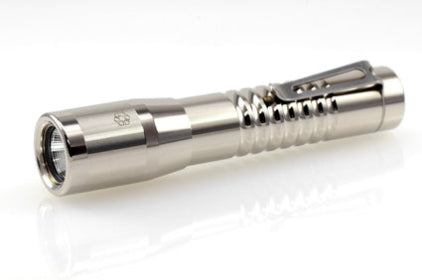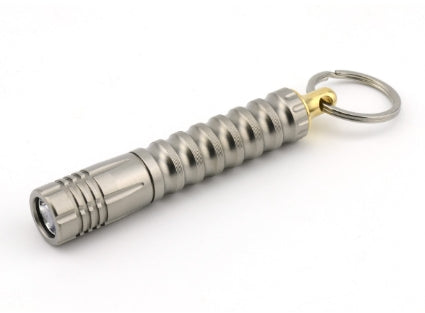Alpha MIL/LEO
 1x18650 |
 Cree MCE |
 700 |
 .5 |
 1.5 hr |
 270 hr |
These lights are restricted to active duty MIL/LEO personnel (now open to FD/EMS as well) because they are very limited in quantity and I want to make sure they are going into the field and not onto someone's desk :) I don't have many ways to give back to those folks, but this is a small gesture to support those who go into harms way on our behalf. Thank you!
When you place an order you'll be asked to provide credentials before we begin the build. You can also place your order using an "official" email address to qualify.
As you know I don't make "tactical" flashlights because I don't engage in hype. Furthermore, I would never call a flashlight "tactical" without direct design input from the MIL/LEO community. However, I do have many MIL/LEO customers who believe the Alpha is an excellent duty light, because every aspect is well balanced and I don't take any shortcuts.
The reason I'm making a "black" flashlight is because those same MIL/LEO customers often request that for a variety of reasons. Remember that direct design input? Yep.
Please note: While the Alpha MIL/LEO shares many similarities with the rest of its Alpha cousins, you should consider this light a prototype that has NOT been fully field tested. That job, and the degree to which you will rely on it, is yours.
One Icarus feature that is specifically oriented towards MIL/LEO users is our "digital drop protection." Most tail switching lights will "jump" levels if they are dropped or struck in such a way that the battery momentarily disconnects from the battery contacts. Basically the light thinks the button has been pushed when it has not. Icarus is programmed to sense the difference between and accidental disconnect (dropping the light) and an intentional disconnect (pressing the button); meaning the light will NOT shift levels during an impact.
Since this is a MIL/LEO oriented light, Alpha lights have a "standard" 1 inch diameter body that is compatible with most after-market weapon mounts. I'll also mention that the "digital drop protection" prevents recoil induced mode switching. I know, cool right?
Flood vs. Spot in tactical situations When you order a MIL/LEO Alpha you can choose your LED, but I still recommend the "Maker's Choice" MCE 4500K LED. I have two theories on this. First, these are 82 CRI minimum and I believe the enhanced color rendering will allow your brain to recognize features and make decisions more quickly. It's just a theory, but when life demands split second decision making, I want to reduce the workload on my brain as much as I can.
Second, I'm with Travis Haley on this one, a floody light is preferable for "scanning" because it allows better use of peripheral vision and prevents target fixation that you get with a more focused beam. He starts talking about it around 6:00 into the video. Obviously if our task requires long-range search, this isn't the right light. If you are looking for massive illumination at 100 feet and closer, nothing will beat this light.
Finally, please check out this beam shot comparison video (above). It's video is old, but clearly illustrates the difference between the Alpha performance/philosophy compared to a very well known tactical flashlight. One good thing about the floody beam is that you can put out a ton of lumens at close range and not be blinded by reflections, while overwhelming the visual system of anyone down range.

















- Alpha Series light
- 1x18650 Foursevens 3400mAh Li-Ion (Protected)
- Battery Case
- XTAR MC1 Charger (Lithium-ion ONLY)

- Maintenance kit (Nano-Oil + replacement o-rings)
- O-ring removal tool with rubber grip
- Three extra button colors of your choice
- Switch Tool (Pronged tool to aid in removal of the switch and retaining ring. 3D printed in-house!)

- Spare UCL window (glass lens) Spare McClicky tailcap switch
-
LED TypeCree MCE Neutral White (4500K)
-
battery type18650 lithium-ion
-
Weight4.79oz (136.1g) No Battery
-
Dimensions1.2" x 5.75" (body dia. is 1")
-
Voltage Range2.8V-4.2V
-
Beam Distance110m
-
Brightness LevelsFully User Programmable (Default is L/M/H)
-
Special ModesStrobe, Beacon, SOS (added via programming)
-
Body Material6061-T6 aluminum with Electroless Nickel plating
-
Window Glass98% transmission UCL glass (2 side AR coated)
-
Water ResistanceIPX8 (100m)
-
Included Accessories1cc Nano Oil + 2 O-rings
-
Where it's made























